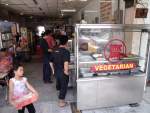Food courts and vegetarian restaurants in Malaysia
June 15, 2010
Topics: Malaysia
We got impression that Malaysian people are not used to cook at home. Their eating habits can be described in two words – Food Courts.
What we have been told by our Chinese-Malaysian friend Chan, about 30 years ago there were lots of food sellers with carriages on the streets. At one point government decided that such food preparation is unhygienic and moved all the cooks into food courts. In nowadays, wherever you go, almost everywhere one will find something similar to restaurants. The only difference is that under one roof operates several independent chefs. Every each of them has his/her own mini kitchen, which looks more like an advanced metal carriage.
In some places one might see a huge eating halls, which looks more like a restaurant market. Hundreds of tables, and dozens of cooks with their own carriages around the area. Most of them are selling non-vegetarian dishes, some might specialize in chicken soup (we see very often posters for “chicken soup”), others will be selling sweets, etc. In Malaysia there are 3 main nations: Malay, Chinese and Indians. So the gourmand will get a chance to taste dishes from all these nations and their mixes.
One Malaysian-Indian driver once told us: “If you would eat meat, all the days of the year would not be enough to taste all the different Malaysian dishes.”
For vegetarians
For traveling vegetarians at least Western coast of Malaysia, where live lots of Chinese, should make no troubles to have variety of tastes. In vegetarian restaurants dominates products of soya and green leafy veggies. Very seldom we see fresh salads on offer, but the good thing is that Chinese tend to only steam vegetables shortly, so they do not loose important nutrients.
We have seen more than 20 different types of soya dishes. Different taste, different preparation and very often every dish has its own non-vegetarian name: chicken, dried beef, fish, etc. It is very difficult to describe all the variety of soya products. There are lots of them, so we suspect, that cheap soya beans are used, which means it is perhaps genetically modified (GM). We got impression that nobody cares about GM stuff in Malaysia…
In the Indian restaurant buffets one can often find tasty dishes without meat. If you are not a fan of spicy food, better do not even bother asking about it the Indian chef. They usually claim that it is spicy, but “just a little bit” or “no spicy at all”, but almost every time food for us was spicy or very spicy, besides the rice.
Sushi
Lovers of Japanese cuisine will be pleased in Malaysia. In the towns one can find sushi restaurants, and in the big supermarkets we always see a section, where they sell dozens of different sushi types. One piece of sushi costs around 1.20-2.00 ringgits (0.3-0.5 EUR), depending on the ingredients. Usually sushi designers of the supermarket will also have a plastic box with mixed type of sushi on offer. Such lunch box in average costs 10 ringgits (2.5 EUR).
Prices
Prices in the food courts are relatively small. A meal costs in average 3 ringgits (0.75 EUR), excluding the drink. In vegetarian restaurants we usually pay 3-4.5 ringgits. We pay depending on how big our eyes are when we see the variety of food in the buffet. Often we take more than we can eat. A portion of a man who plays small and predicts well how big should be his lunch – costs not more than 3 ringgits.
People say it is tasty
It is tasty to eat in the restaurants. It is tasty for us. People say it is tasty for them. That’s why there is such a big culture eating outside. But let’s not forget one thing: in South-East Asia cooks often use flavour enhancer monosodium glutamate, or MSG in short. In Europe this food additive is marked as E621 and some sources recommend to avoid it. This additive is always added into chips, that’s why chips are “addictive” – in other words very tasty. One kg of MSG in the shop nearby us costs 7.60 ringgit (1.90 EUR). Have a nice meal! 🙂

















The advatange of dining at food court in Malaysia is that the food is cheap and more importantly, they are tasty. In fact, eating out at hawker stall is the most common culture of Malaysians.